The Indian Rupee is the official currency of India (Bhārat). The rupee is represented by the symbol ₹ and its ISO 4217 code is INR. This currency is issued by the Reserve Bank of India (RBI), founded on April 1, 1935 by the Reserve Bank of India Act and headquartered in Bombay.
Compare rates at 103 currency stores in 34 cities (free service)
Depending on the geographical area of India you move through, we speak of rupees, but also of “rupaya”, “roopayi”, “rubai” or “ropa”.
The value of the rupee currency against the euro is quite low. As of this post update (October 24, 2023):
- 1 euro is equivalent to 87.94 rupees
- 100 rupees are equivalent to 1.14 euros
The Indian rupee is a commonly used currency, as well as in the Republic of India in Bhutan (along with the Ngultrum) and in Nepal.
Several Asian countries share the rupee denomination for their national currency: Indonesia (Indonesian rupee), Sri Lanka (Sri Lankan rupee), Pakistan, Nepal, Mauritius (Mauritian rupee), Seychelles and Maldives, in addition to Indonesia (Indonesian rupee).
History of the Indian Rupee
Compare rates at 103 currency stores in 34 cities (free service)
India was one of the first Asian territories to mint currency. Already in the 6th century BC it is believed that the “rupee” was coined for the first time by the hand of Emperor Sher Sacha Suri. At that time they also talked about the parts of the rupee (one rupee was equivalent to 40 paise of copper).
With the independence of India from the British Empire on August 15, 1947 (independence movements began in 1857) moves were made to introduce decimalization of the rupee.
In September 1955 the Indian Coinage Act 1906 was amended to facilitate the “decimalization” of the rupee. As of April 1, 1957, the rupee becomes 100 paisos, and the previous equivalence of 1 rupee = 16 annas, or 1 rupee = 64 pices, is abandoned.
Indian rupee coins
The rupee is divided into 100 “paise”. Currently, coins of 50 paise, and 1, 2, 5 and 10 rupees circulate in India.
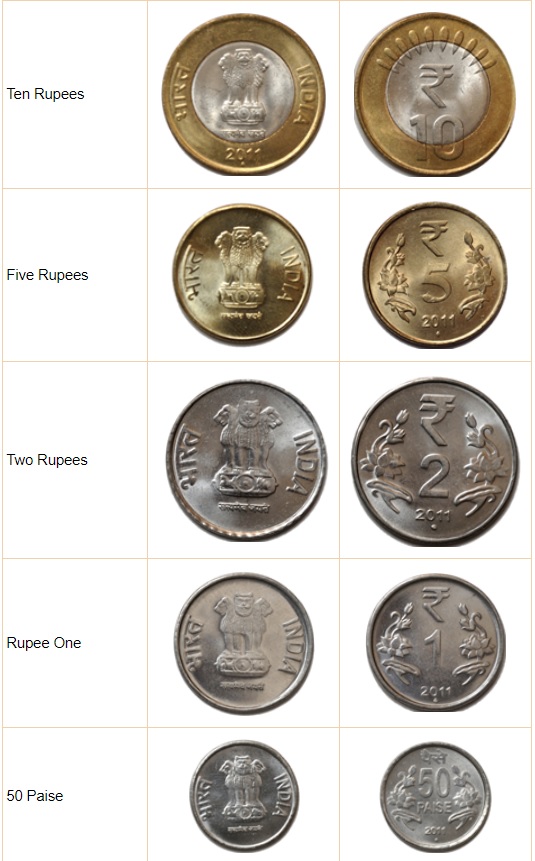
Indian rupee coins
Withdrawal of coins of 25 paise and below
Their value being so small, since June 2011 the Government of India decided to withdraw from circulation all coins of 25 paise and lower values. Keep this in mind if they try to “turn you around” in India with this type of out-of-use “pocket change.”
Indian rupee banknotes
Indian rupee notes legal tender in 2022 have the following denominations (official source): ₹10, ₹20, ₹50, ₹100, ₹200, ₹500 and ₹2000.
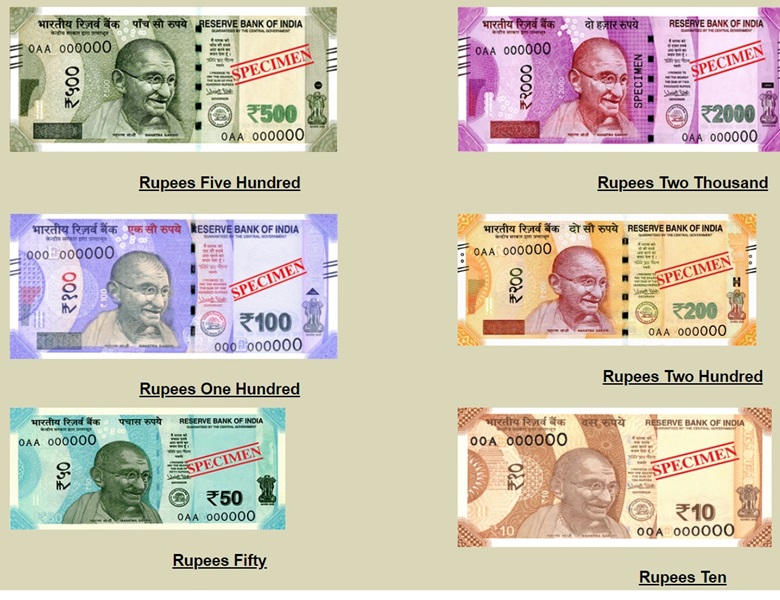
Indian rupee banknotes
They all belong to the series dedicated to the figure of the activist Mahatma Gandhi (Mahatma Gandhi series) varying their sizes, colors and backs. But all the obverses are similar as you can see below (the 20 INR note is missing):
The 1000 rupee notes are no longer in circulation (see below).
10 Indian rupee banknote
The 10 Indian Rupee (10 INR) banknote is brown in color, measures 123 x 63 mm and entered circulation in India in January 2018 (its predecessor dates back to 1996).
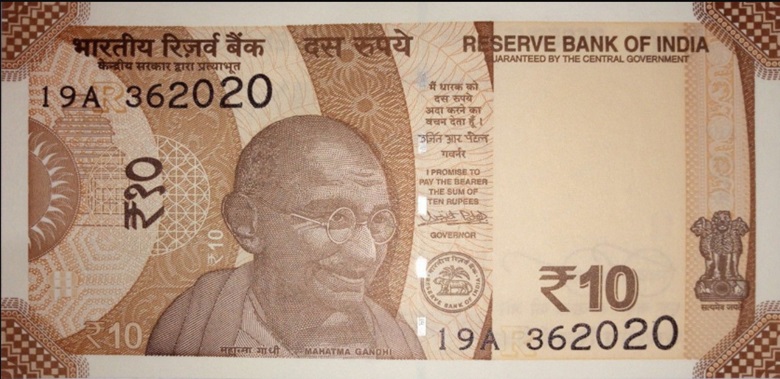
10 Indian rupee banknote obverse
On the reverse you can see the “Sun Temple” of Konark (Surya Mandira) from the 13th century. It is situated at Konark about 35 kilometers northeast of Puri on the Odisha coast.
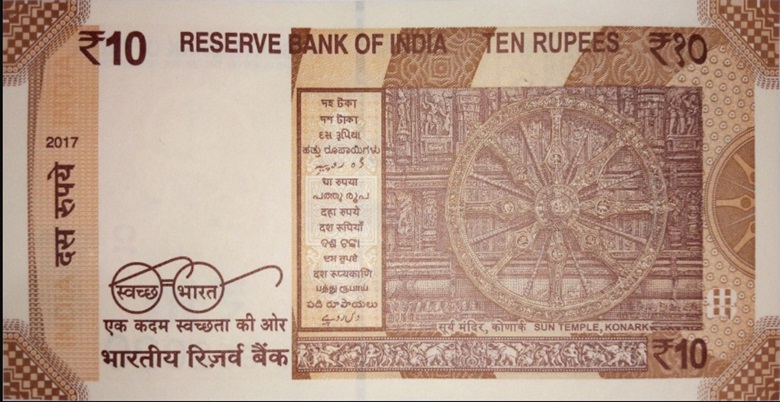
10 Indian rupee banknote reverse
Its equivalent value in euros in October 2023 in Spain is low, 11 euro cents.
20 Indian rupee banknote
The 20 Indian Rupee (20 INR) note is brown and yellow in color and was launched in August 2001 (its predecessor dates back to 1972). Its equivalent value in euros in October 2023 in Spain is low, 22 euro cents.
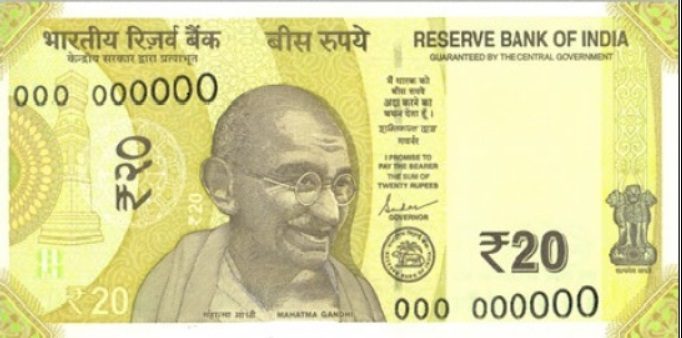
20 Indian rupee banknote obverse
On the reverse side are the Ellora Caves (Aurangabad district of Maharashtra), a UNESCO heritage site.
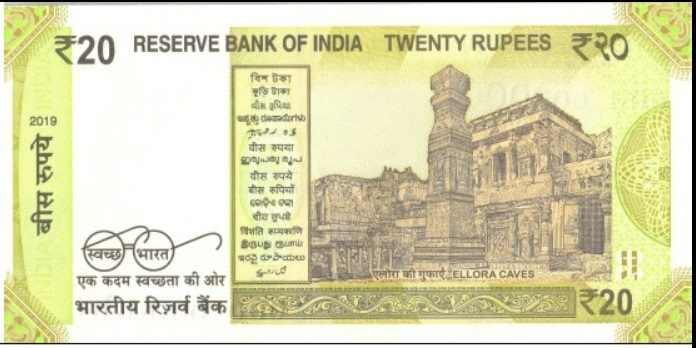
20 Indian rupee banknote reverse
50 Indian rupee banknote
The 50 Indian Rupee (50 INR) note is bluish in color and measures 135 x 66 mm. It was put into circulation in August 2017 and its equivalent value in euros in October 2023 in Spain is 53 euro cents.
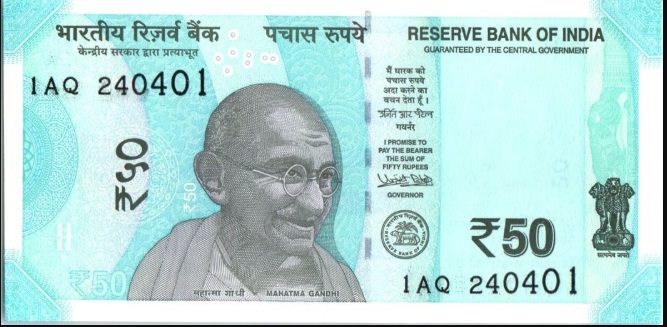
50 Indian rupee banknote obverse
On the reverse you can see a representation of the monumental complex of Hampi (Hampe), a UNESCO world heritage site located in east-central Karnataka and known for being the pilgrimage center of the Hindu religion.
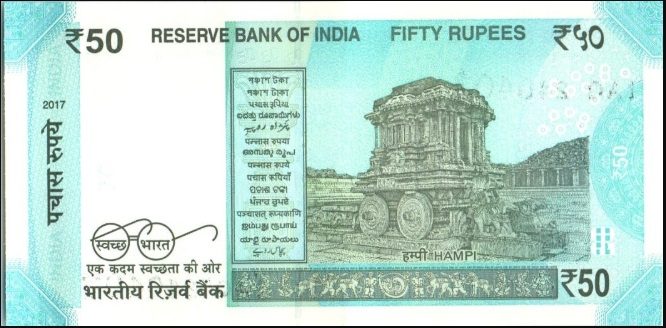
50 Indian rupee banknote reverse
100 Indian rupee banknote
The 100 Indian Rupee (INR 100) note is purple in color and measures 142 x 66 mm. It was put into circulation in July 2018 and its equivalent value in euros in October 2023 in Spain is low, 1.06 euros.
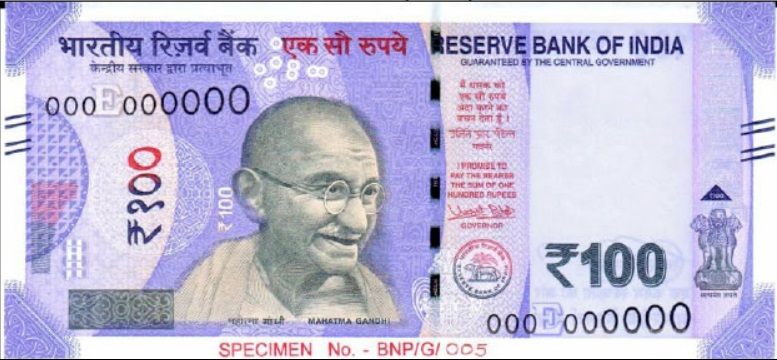
100 Indian rupee banknote obverse
On the reverse there is a representation of another UNESCO heritage monument: Rani ki Vav or Ranki vav in the city of Patan in the Indian state of Gujarat. It is located on the banks of the Saraswati River.
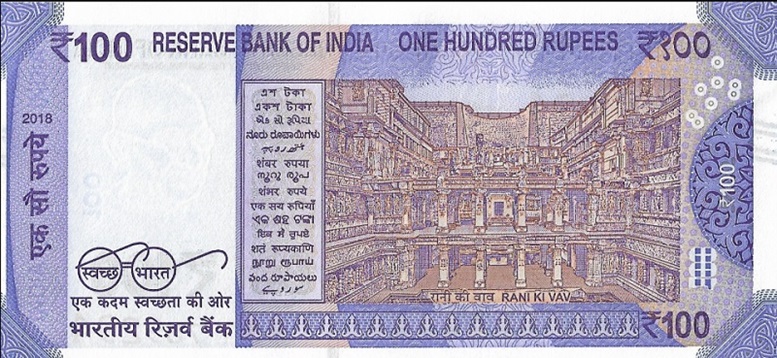
100 Indian rupee banknote reverse
Its construction dates back to the 11th century and was rediscovered in 1940 and restored in 1980 by the Archaeological Survey of India.
200 Indian rupees banknote
The 200 Indian Rupee (INR 200) note is brown in color and measures 146 x 66 mm. It was put into circulation in August 2017 and its equivalent value in euros in October 2023 in Spain is 2.12 euros.
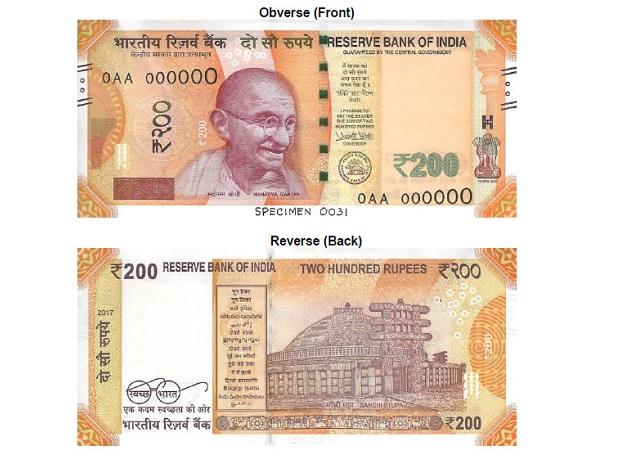
200 Indian rupee banknote
The reverse is dedicated to the Buddhist temple of Sanchi Stupa, famous for its Great Stupa. The temple is situated on a hill in the town of Sanchi in Raisen district, Madhya Pradesh state, India. It is located 46 kilometers northeast of Bhopal, capital of Madhya Pradesh.
500 Indian rupee banknote
The 500 Indian Rupee (INR 500) note is brown in color and measures 150 x 66 mm. It was put into circulation in November 2016 and its equivalent value in euros in October 2023 in Spain is low, 5.30 euros.
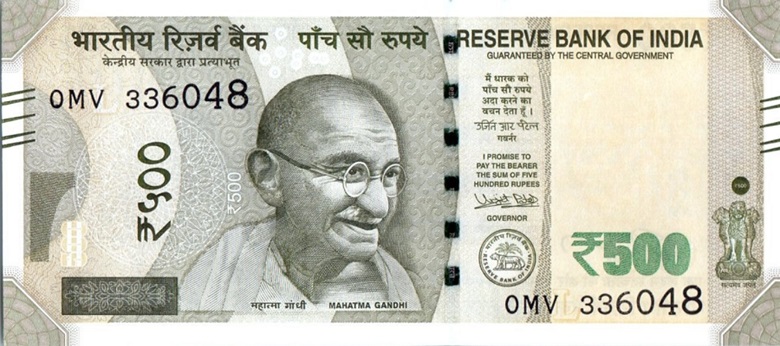
500 Indian rupee banknote obverse
The reverse is dedicated to the Red Fort of Delhi, which served as the main residence of the Mughal emperors (17th century) when they moved their capital from Agra to Delhi.
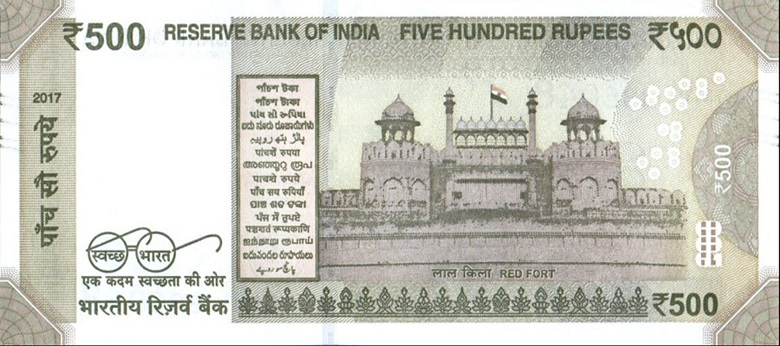
500 Indian rupee banknote reverse
The building is attributed to the architect Ustad Ahmad Lahori, who also built the Taj Mahal. It was built between May 1639 and April 1648.
Withdrawal of 1000 INR notes and old series of 500 INR
In February 2017, the Government of India published a rule (Specified Banknotes -Cessation of liabilities- Act 2017) to withdraw from the market all then existing banknotes with denominations of ₹500 and ₹1000. The purpose of this rule was to combat the high number of counterfeit banknotes of these two denominations in circulation, used for terrorism and/or money laundering operations.
The Government gave a deadline until December 30, 2016 to dispose of these notes at local Post offices, banks and RBI branches. Later a new ₹500 note was issued but not the ₹1000 note.
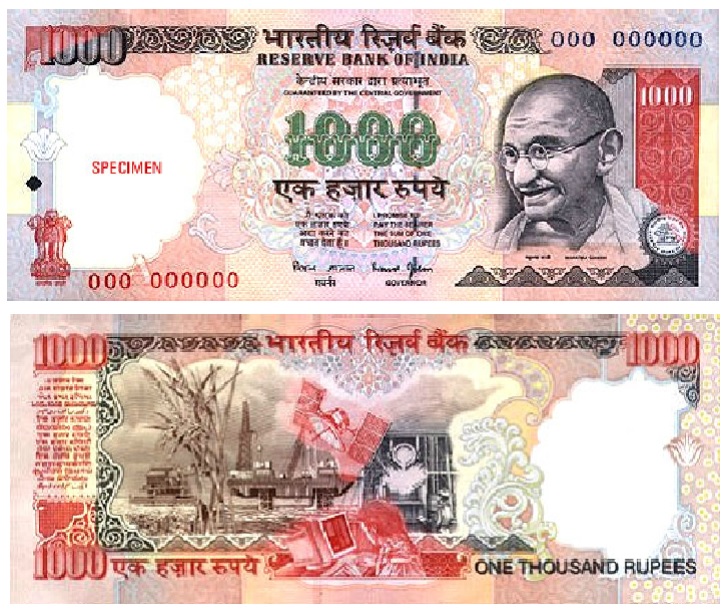
1000 Indian rupee banknote
So be careful and don’t be given any of these denominations if you decide to change there or if they give you change for a 2000 rupee note.
2000 Indian rupees banknote
The 2000 Indian Rupee (2000 INR) note is brown in color and measures 150 x 66 mm. It was put into circulation in November 2016 and its equivalent value in euros in October 2023 in Spain is low, 21.20 euros.
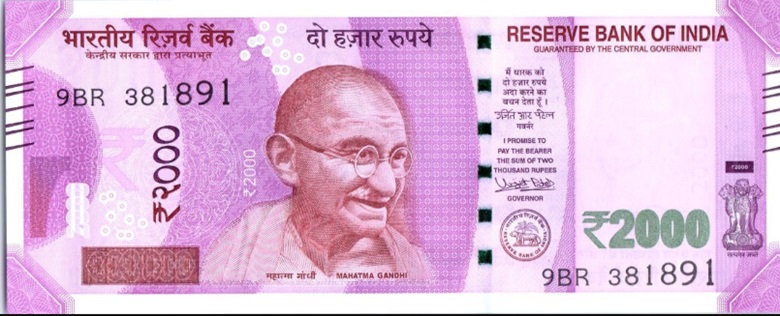
2000 Indian rupee banknote obverse
Its reverse is dedicated to astronautics. Specifically, the Mangalyaan probe (“Mars ship”), a space probe in orbit around Mars since September 24, 2014.
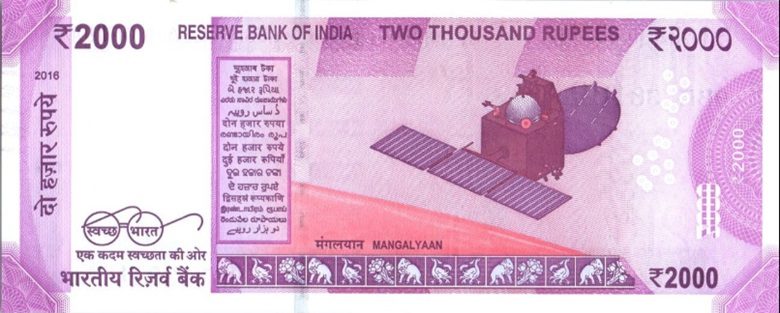
2000 Indian rupee banknote reverse
It was launched on November 5, 2013 by the Indian Space Research Organization (ISRO). on its first interplanetary mission from India. Thanks to this feat, India is the first Asian nation to reach Mars orbit and the first nation in the world to do so on its first attempt.
Euro to Indian rupee exchange rate
The exchange rate of the euro against the rupee fluctuates at all times. If you search on Google for “Euro to Indian rupee exchange rate” you will find dozens of websites like Oanda (called “currency converters”) that offer a “rate” of the day.
You will also see this graph with the prices of that pair of currencies from Google Finance. Something like this (October 24, 2023):
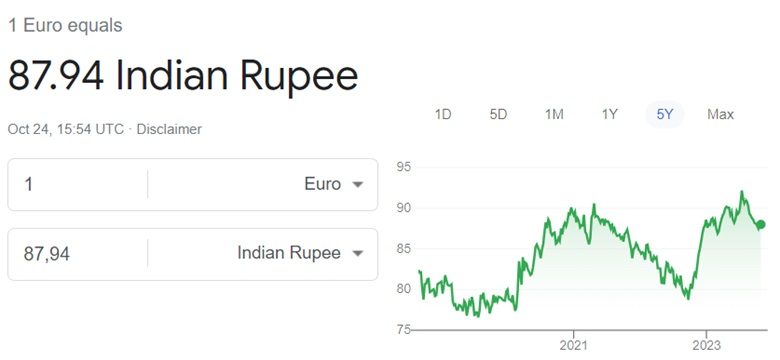
Euro to Indian rupee exchange rate October 24 2023
As you can see, the exchange rate last year has fluctuated between 77 and 92 rupees per euro for the last five years with the current price (October 24, 2023) of 87.94 rupees per euro.
But keep in mind that this graph represents the value of the Indian rupee “currency” against the euro, and not the value of the actual currency, which is lower. In fact, in the exchange offices in Spain you can buy “rupiahs” today at an exchange rate between 60.41 (the price they give you in the main Spanish airports today) and 77.82 INR, for every euro you gives you Cambiator. Nothing to do with the euro to rupee currency exchange.
So, when you see these values on Google and other currency converters with your mobile, keep this in mind:
-This is an unofficial rate, and therefore, unreliable. That is, if you click on the “Disclaimer” link, you get this warning from Google Finance: “Google cannot guarantee the accuracy of the exchange rates displayed. Please confirm current rates before conducting a transaction that may be affected by changes in exchange rates.”
-These rates that you see are usually wholesale prices of the Indian rupee currency against the euro currency (currency and banknotes of the same currency are not the same).
-These rates can only be had between banks, that is, it is impossible to obtain them as an individual.
If you need rupees in banknotes you will have to go through the retail banknote market (bank or currency supplier). This means that the Indian rupees have had to be “transported” by someone for you to enjoy them (or purchased from travelers from India, passing through Spain previously).
That is to say, moving banknotes from one place to another has logistical costs that will make their sale price (the exchange rate that whoever sells it to you apply) more expensive.
The Indian rupee is a currency that is not very common or abundant in Spain, so it is not so easy to find it available for sale. Therefore, it is good to anticipate the purchase and order it online to obtain a better price.
Where to exchange Indian rupees in Spain
The 3 most popular places to exchange INR in Spain are banks, currency suppliers and the airport.
Of them, the least advisable place to buy is the airport and any business that charges you a commission in addition to an “exchange margin” (difference between the price for which you paid the currency and the price for which it is sold to you).
For their part, none of the 4 big banks exchange rupees for you in Spain (BBVA, Santander, Sabadell and Caixa). ING does sell them through the agreement it has with Global Exchange and EVO through the agreement it has with Exact Change, but these two suppliers have uncompetitive rates (we advise you to compare their rates with those of the currency suppliers that do collaborate with Cambiator).
Simulation: exchange of 1000 euros to Indian rupees
Let’s see how the purchase rates of Indian rupees are today in Spain with 1000 euros, with the help of this comparative table.
In the case of banks (neither BBVA, nor Santander, nor Sabadell, nor Caixabank sell them, but ING does through an agreement with Global Exchange currency supplier). Airport prices are taken from the Global Exchange´s website:
| Currecny to buy (INR) | Exchange rate (24th October 2023) | 1000 EUR = |
|---|---|---|
| Alicante airport (Global Exchange)* |
59,791212 | 59.791 INR |
| Madrid, Barcelone and Malaga airports (Global Exchange)* | 60,415531 | 60.425 INR |
| Global Exchange (home delivery)* | 75,577333 | 75.577 INR |
| Cambiator | 77,821014 | 77.821 INR |
*Rates extracted from the ING, Global Exchange and Cambiator websites today 1st 24, 2023.
-Cambiator has today the best euro to Indian rupee exchange rate and it does not charge you a commission. For 1,000 euros we give you 77,821 rupees.
-Global Exchange would give you 59,791 Indian rupees for those same euros at Alicante airport and 60,425 INR in Madrid-Barajas, Barcelona or Malaga.
-The difference between buying crowns at Alicante airport or at Cambiator is amazing. That is, 18,030 Indian rupees less (which at the exchange rate is about 191 euros less at Alicante airport).
For this reason, it is important to avoid expensive places like the airport (they do not charge you a commission but they do charge you a very bad exchange rate) or where they charge you commissions in addition to an “exchange rate” (banks and some currency suppliers that do not collaborate with Cambiator).
The currency suppliers that collaborate with Cambiator do not charge you a commission and also have very competitive rates.
Euro to Indian rupee exchange rate today
To know the euro-Indian rupee exchange rate, the best thing you can do is use our currency comparator.
- Exchange euros to Indian Rupees (EUR-INR)
- Convert Indian Rupees to Euros (INR-EUR)
Other popular currencies
Best rate of the day (exchange euros to another currency)
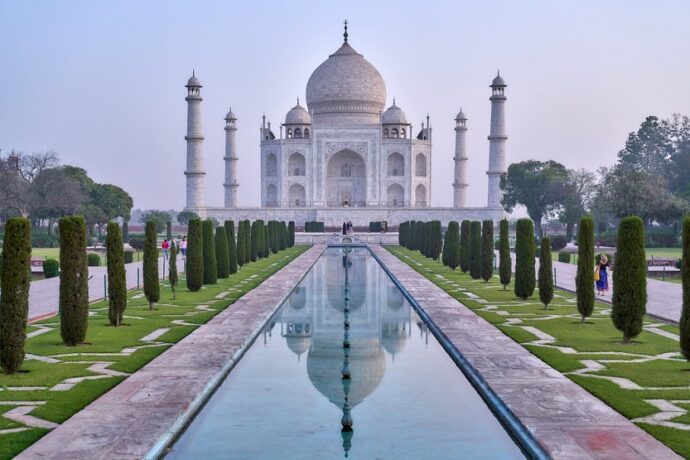
Sin comentarios